Multifunctional Properties of Binary Polyrhodanine Manganese Ferrite Nanohybrids—From the Energy Converters to Biological Activity
Abstract
1. Introduction
2. Materials and Methods
2.1. Synthesis of Stock MnFe2O4 and PRHD@MnFe2O4 Binary Hybrids
2.1.1. Microwave Driven Solvothermal Synthesis of MnFe2O4 Nanoparticles
2.1.2. Synthetic Protocol for Binary Hybrids Preparation
2.2. Apparatus
2.3. Evaluation of Cytotoxicity of PRHD and PRHD@MnFe2O4 Hybrids Using Macrophages (RAW 264.7), Osteosarcoma Cells Line (UMR-106), and Stromal Progenitor Cells of Adipose Tissue (ASCs)
2.4. Microbiological Sensitivity of PRHD and PRHD@MnFe2O4 Hybrids on Escherichia coli ATCC 8739 and Staphylococcus aureus ATCC 25923 Bacteria
3. Results
3.1. Physicochemical Properties of Binary PRHD@MnFe2O4 Hybrids
3.2. Effectiveness of Heat Induction by PRHD@MnFe2O4 Binary Hybrids
3.3. Evaluation of Cytotoxicity of PRHD and PRHD@MnFe2O4 Hybrids Using Macrophages (RAW 264.7), Osteosarcoma Cells Line (UMR-106), and Stromal Progenitor Cells of Adipose Tissue (ASCs)
3.4. Microbiological Sensitivity of PRHD and PRHD@MnFe2O4 Hybrids on Escherichia coli ATCC 8739 and Staphylococcus aureus ATCC 25923 Bacteria
4. Conclusions
Author Contributions
Funding
Acknowledgments
Conflicts of Interest
References
- Mehta, R.V. Synthesis of magnetic nanoparticles and their dispersions with special reference to applications in biomedicine and biotechnology. Mater. Sci. Eng. C 2017, 79, 901–916. [Google Scholar] [CrossRef]
- Lisjak, D.; Mertelj, A. Anisotropic magnetic nanoparticles: A review of their properties, syntheses and potential applications. Prog. Mater. Sci. 2018, 95, 286–328. [Google Scholar] [CrossRef]
- Pedram, M.Z.; Shamloo, A.; Alasty, A.; Ghafar-Zadeh, E. Optimal magnetic field for crossing super-para-magnetic nanoparticles through the Brain Blood Barrier: A computational approach. Biosensors 2016, 6, 25. [Google Scholar] [CrossRef] [PubMed]
- Espinosa, A.; Di Corato, R.; Kolosnjaj-Tabi, J.; Flaud, P.; Pellegrino, T.; Wilhelm, C. Duality of Iron Oxide Nanoparticles in Cancer Therapy: Amplification of Heating Efficiency by Magnetic Hyperthermia and Photothermal Bimodal Treatment. ACS Nano 2016, 10, 2436–2446. [Google Scholar] [CrossRef] [PubMed]
- Pązik, R.; Lewińska, A.; Adamczyk-Grochala, J.; Kulpa-Greszta, M.; Kłoda, P.; Tomaszewska, A.; Dziedzic, A.; Litwienienko, G.; Noga, M.; Sikora, D.; et al. Energy Conversion and Biocompatibility of Surface Functionalized Magnetite Nanoparticles with Phosphonic Moieties. J. Phys. Chem. B 2020, 124, 4931–4948. [Google Scholar] [CrossRef] [PubMed]
- Ortgies, D.H.; Teran, F.J.; Rocha, U.; de la Cueva, L.; Salas, G.; Cabrera, D.; Vanetsev, A.S.; Rähn, M.; Sammelselg, V.; Orlovskii, Y.V.; et al. Optomagnetic Nanoplatforms for In Situ Controlled Hyperthermia. Adv. Funct. Mater. 2018, 28, 1–11. [Google Scholar] [CrossRef]
- Ahrens, E.T.; Bulte, J.W.M. Tracking immune cells in vivo using magnetic resonance imaging. Nat. Rev. Immunol. 2013, 13, 755–763. [Google Scholar] [CrossRef]
- Zhang, Y.; Zhang, Q.; Zhang, A.; Pan, S.; Cheng, J.; Zhi, X.; Ding, X.; Hong, L.; Zi, M.; Cui, D.; et al. Multifunctional co-loaded magnetic nanocapsules for enhancing targeted MR imaging and in vivo photodynamic therapy. Nanomed. Nanotechnol. Biol. Med. 2019, 21, 102047. [Google Scholar] [CrossRef]
- Arruebo, M.; Fernández-Pacheco, R.; Ibarra, M.R.; Santamaría, J. Magnetic nanoparticles Controlled release of drugs from nanostructured functional materials. Nano Today 2007, 2, 22–32. [Google Scholar] [CrossRef]
- Zhao, T.; Chen, L.; Li, Q.; Li, X. Near-infrared light triggered drug release from mesoporous silica nanoparticles. J. Mater. Chem. B 2018, 6, 7112–7121. [Google Scholar] [CrossRef] [PubMed]
- Chitgupi, U.; Qin, Y.; Lovell, J.F. Targeted nanomaterials for phototherapy. Nanotheranostics 2017, 1, 38–58. [Google Scholar] [CrossRef] [PubMed]
- Pązik, R.; Zachanowicz, E.; Pożniak, B.; Małecka, M.; Zięcina, A.; Marciniak, Ł. Non-contact Mn 1−x Ni x Fe2O4 ferrite nano-heaters for biological applications—Heat energy generated by NIR irradiation. RSC Adv. 2017, 7, 18162–18171. [Google Scholar] [CrossRef]
- Rivas, P.; Sagredo, V.; Rossi, F.; Pernechele, C.; Solzi, M.; Peña, O. Structural, magnetic, and optical characterization of MnFe2O4 nanoparticles synthesized via sol-gel method. IEEE Trans. Magn. 2013, 49, 4568–4571. [Google Scholar] [CrossRef]
- Islam, R.; Borah, J.P. Ab initio study of electronic structure and enhancement of magnetocrystalline anisotropy in MnFe2O4 for permanent magnet application. J. Magn. Magn. Mater. 2020, 499, 166268. [Google Scholar] [CrossRef]
- Pereira, M.C.; Oliveira, L.C.A.; Murad, E. Iron oxide catalysts: Fenton and Fenton like reactions—A review. Clay Miner. 2012, 47, 285–302. [Google Scholar] [CrossRef]
- Uhl, L.; Gerstel, A.; Chabalier, M.; Dukan, S. Hydrogen peroxide induced cell death: One or two modes of action? Heliyon 2015, 1, e00049. [Google Scholar] [CrossRef] [PubMed]
- Barbusiński, K. Controversy Over Fenton Mechanism. Ecol. Chem. Eng. S 2009, 16, 347–358. [Google Scholar]
- Torchilin, V.P.; Trubetskoy, V.S. Which polymers can make nanoparticulate drug carriers long-circulating? Adv. Drug Deliv. Rev. 1995, 16, 141–155. [Google Scholar] [CrossRef]
- Zachanowicz, E.; Pigłowski, J.; Zięcina, A.; Rogacki, K.; Poźniak, B.; Tikhomirov, M.; Marędziak, M.; Marycz, K.; Kisała, J.; Hęclik, K.; et al. Polyrhodanine cobalt ferrite (PRHD@CoFe2O4) hybrid nanomaterials—Synthesis, structural, magnetic, cytotoxic and antibacterial properties. Mater. Chem. Phys. 2018, 217, 553–561. [Google Scholar] [CrossRef]
- Song, J.; Kim, H.; Jang, Y.; Jang, J. Enhanced antibacterial activity of silver/polyrhodanine-composite-decorated silica nanoparticles. ACS Appl. Mater. Interfaces 2013, 5, 11563–11568. [Google Scholar] [CrossRef]
- Soleymani Lashkenrai, A.; Najafi, M.; Peyravi, M.; Jahanshahi, M.; Mosavian, M.T.H.; Amiri, A.; Shahavi, M.H. Direct filtration procedure to attain antibacterial TFC membrane: A facile developing route of membrane surface properties and fouling resistance. Chem. Eng. Res. Des. 2019, 149, 158–168. [Google Scholar] [CrossRef]
- Seraj, S.; Mirzayi, B.; Nematollahzadeh, A. Engineered maghemite nanoparticles with polyrhodanine for efficient removal of Cr(VI) from water. Environ. Nanotechnol. Monit. Manag. 2018, 10, 94–103. [Google Scholar] [CrossRef]
- Pązik, R.; Piasecka, E.; Małecka, M.; Kessler, V.G.; Idzikowski, B.; Śniadecki, Z.; Wiglusz, R.J. Facile non-hydrolytic synthesis of highly water dispersible, surfactant free nanoparticles of synthetic MFe2O4 (M–Mn2+, Fe2+, Co2+, Ni2+) ferrite spinel by a modified Bradley reaction. RSC Adv. 2013, 3, 12230. [Google Scholar] [CrossRef]
- Hohne, G.W.H.; Hemminger, W.F.; Flammersheim, H.J. Differential Scanning Calorimetry; Springer: Berlin, Germany, 2003. [Google Scholar]
- Kornicka, K.; Houston, J.; Marycz, K. Dysfunction of Mesenchymal Stem Cells Isolated from Metabolic Syndrome and Type 2 Diabetic Patients as Result of Oxidative Stress and Autophagy may Limit Their Potential Therapeutic Use. Stem Cell Rev. Rep. 2018, 14, 337–345. [Google Scholar] [CrossRef] [PubMed]
- Marycz, K.; Tomaszewski, K.A.; Kornicka, K.; Henry, B.M.; Wroński, S.; Tarasiuk, J.; Maredziak, M. Metformin Decreases Reactive Oxygen Species, Enhances Osteogenic Properties of Adipose-Derived Multipotent Mesenchymal Stem Cells In Vitro, and Increases Bone Density In Vivo. Oxid. Med. Cell. Longev. 2016, 9785890. [Google Scholar] [CrossRef] [PubMed]
- Marycz, K.; Kornicka, K.; Szlapka-Kosarzewska, J.; Weiss, C. Excessive endoplasmic reticulum stress correlates with impaired mitochondrial dynamics, mitophagy and apoptosis, in liver and adipose tissue, but not in muscles in EMS horses. Int. J. Mol. Sci. 2018, 19, 165. [Google Scholar] [CrossRef]
- Rahmanzadeh, L.; Ghorbani, M.; Jahanshahi, M. Synthesis and Characterization of Fe3O4 @ Polyrhodanine Nanocomposite with Core-Shell Morphology. Adv. Polym. Technol. 2014, 33, 21463. [Google Scholar] [CrossRef]
- Kong, H.; Song, J.; Jang, J. One-step fabrication of magnetic γ-Fe2O3/polyrhodanine nanoparticles using in situ chemical oxidation polymerization and their antibacterial properties. Chem. Commun. 2010, 46, 6735–6737. [Google Scholar] [CrossRef]
- Ramankutty, C.G.; Sugunan, S. Surface properties and catalytic activity of ferrospinels of nickel, cobalt and copper, prepared by soft chemical methods. Appl. Catal. A 2001, 218, 39–51. [Google Scholar] [CrossRef]
- Yang, Z.; Kuang, W.; Weng, P.; Tang, Z.; Guo, B. Graphene oxide/rhodanine redox chemistry and its application in designing high-performance elastomer/graphene composites. RSC Adv. 2015, 5, 84398–84405. [Google Scholar] [CrossRef]
- Ibrahim, I.; Ali, I.O.; Salama, T.M.; Bahgat, A.A.; Mohamed, M.M. Synthesis of magnetically recyclable spinel ferrite (MFe2O4, M=Zn, Co, Mn) nanocrystals engineered by sol gel-hydrothermal technology: High catalytic performances for nitroarenes reduction. Appl. Catal. B Environ. 2016, 181, 389–402. [Google Scholar] [CrossRef]
- Jaque, D.; Martínez Maestro, L.; del Rosal, B.; Haro-Gonzalez, P.; Benayas, A.; Plaza, J.L.; Martín Rodríguez, E.; García Solé, J. Nanoparticles for photothermal therapies. Nanoscale 2014, 6, 9494–9530. [Google Scholar] [CrossRef] [PubMed]
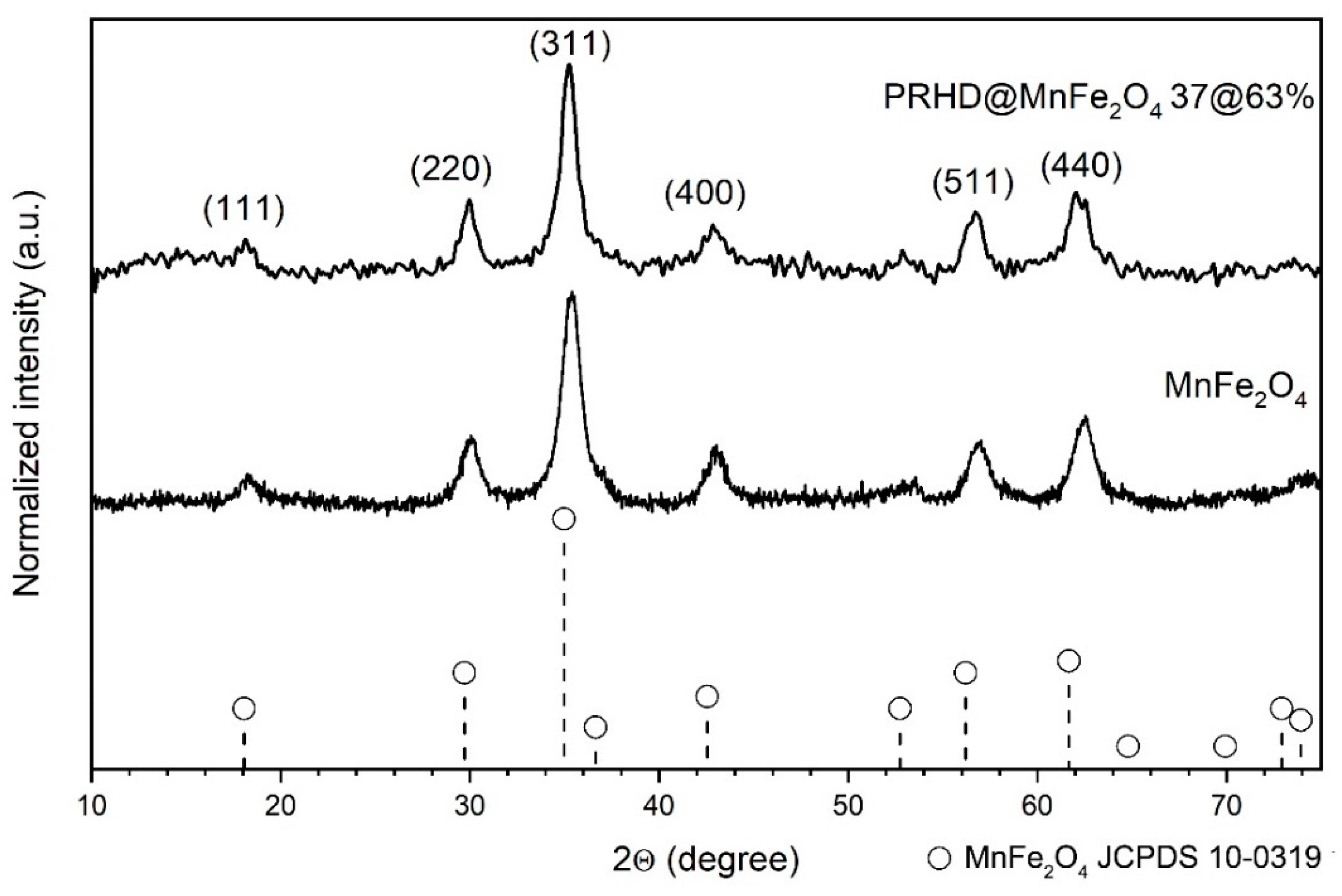

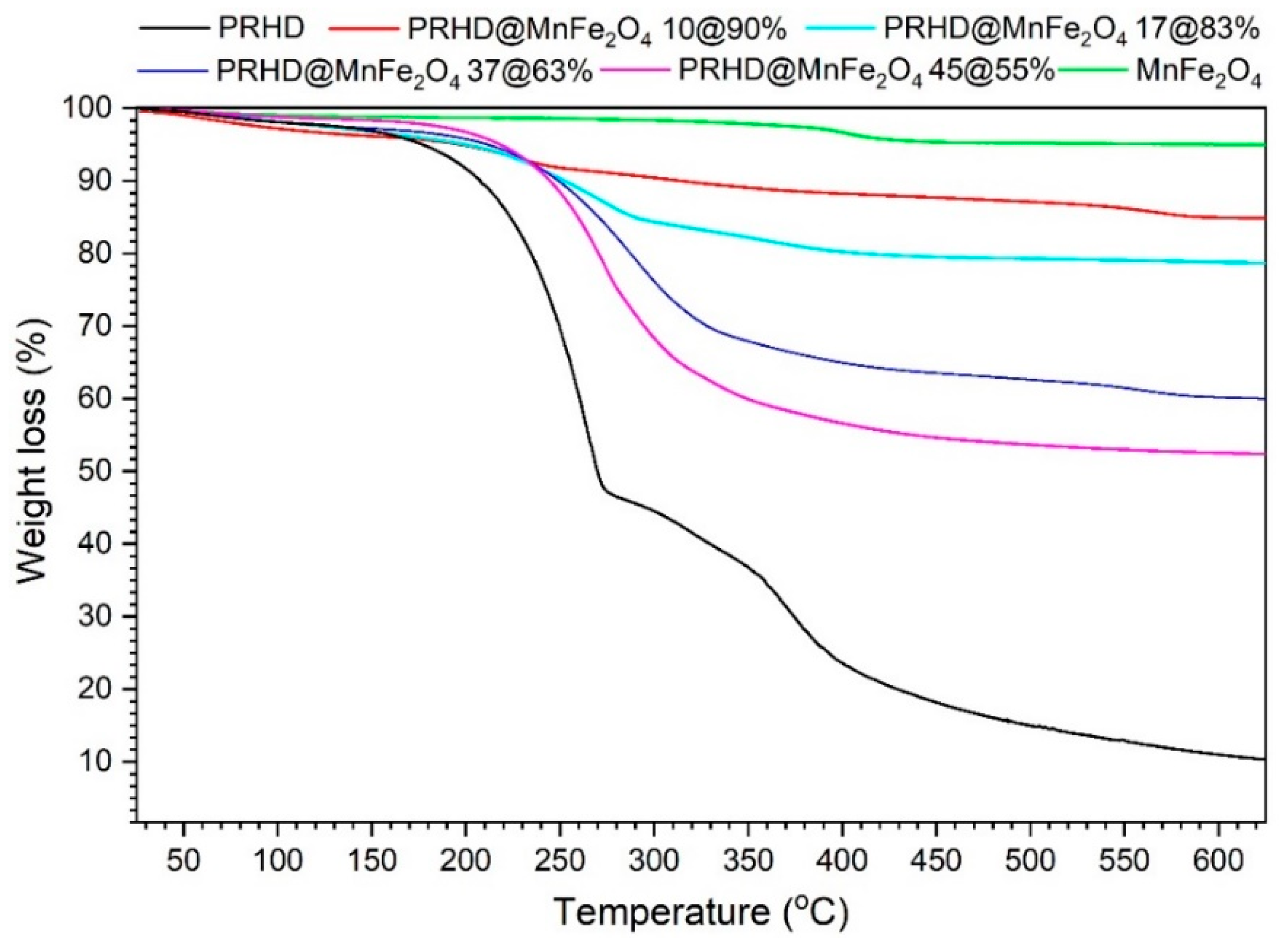
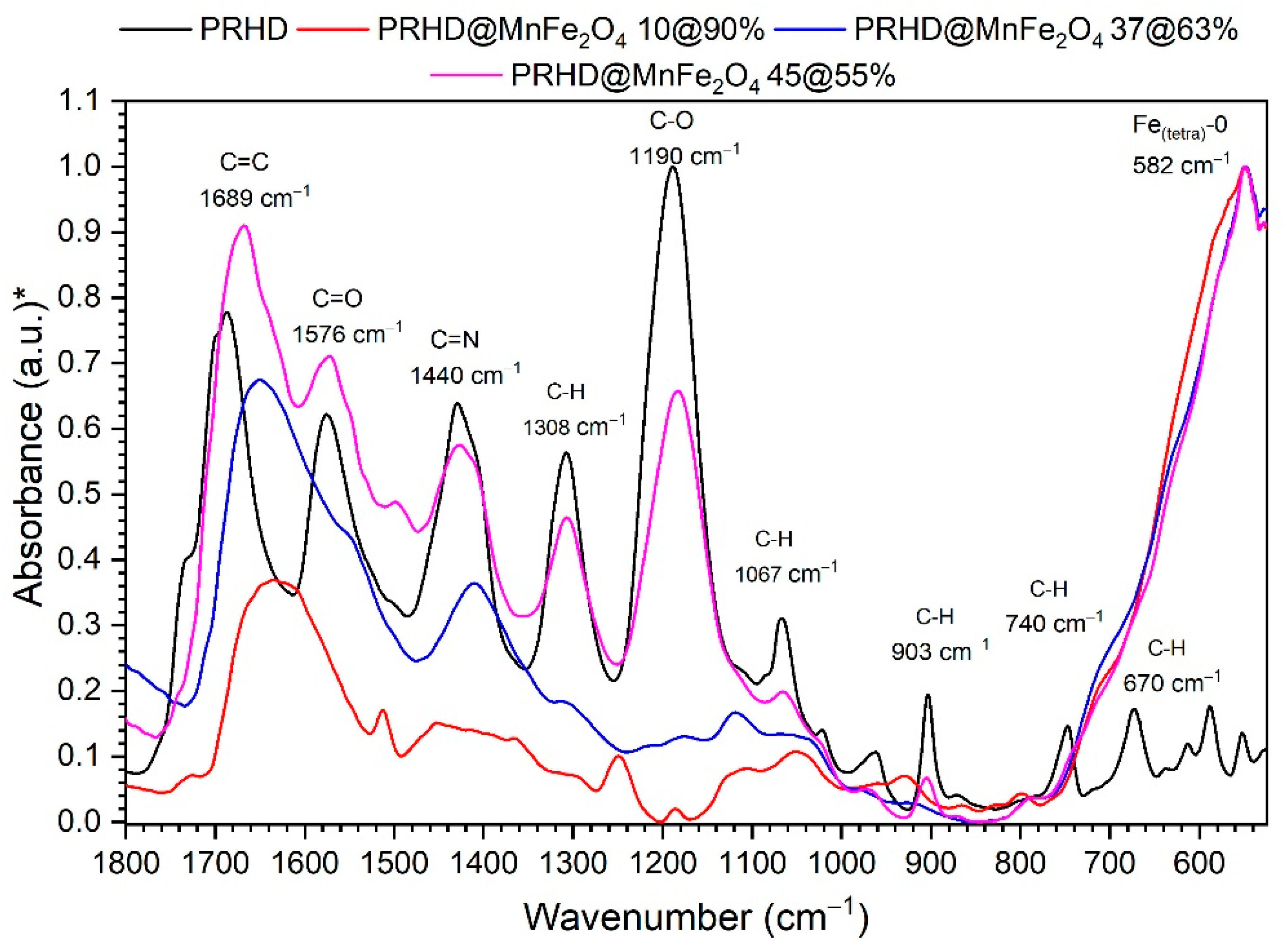
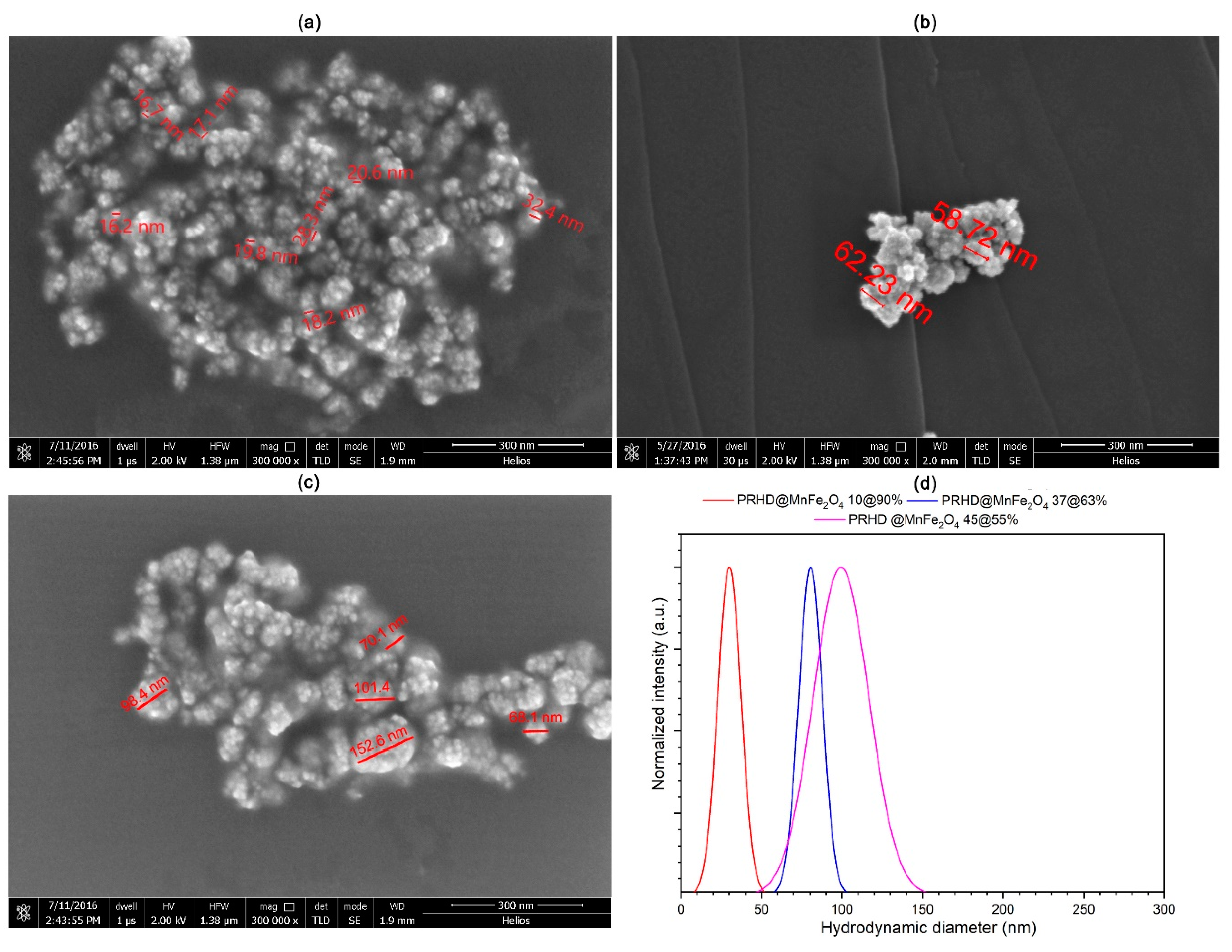


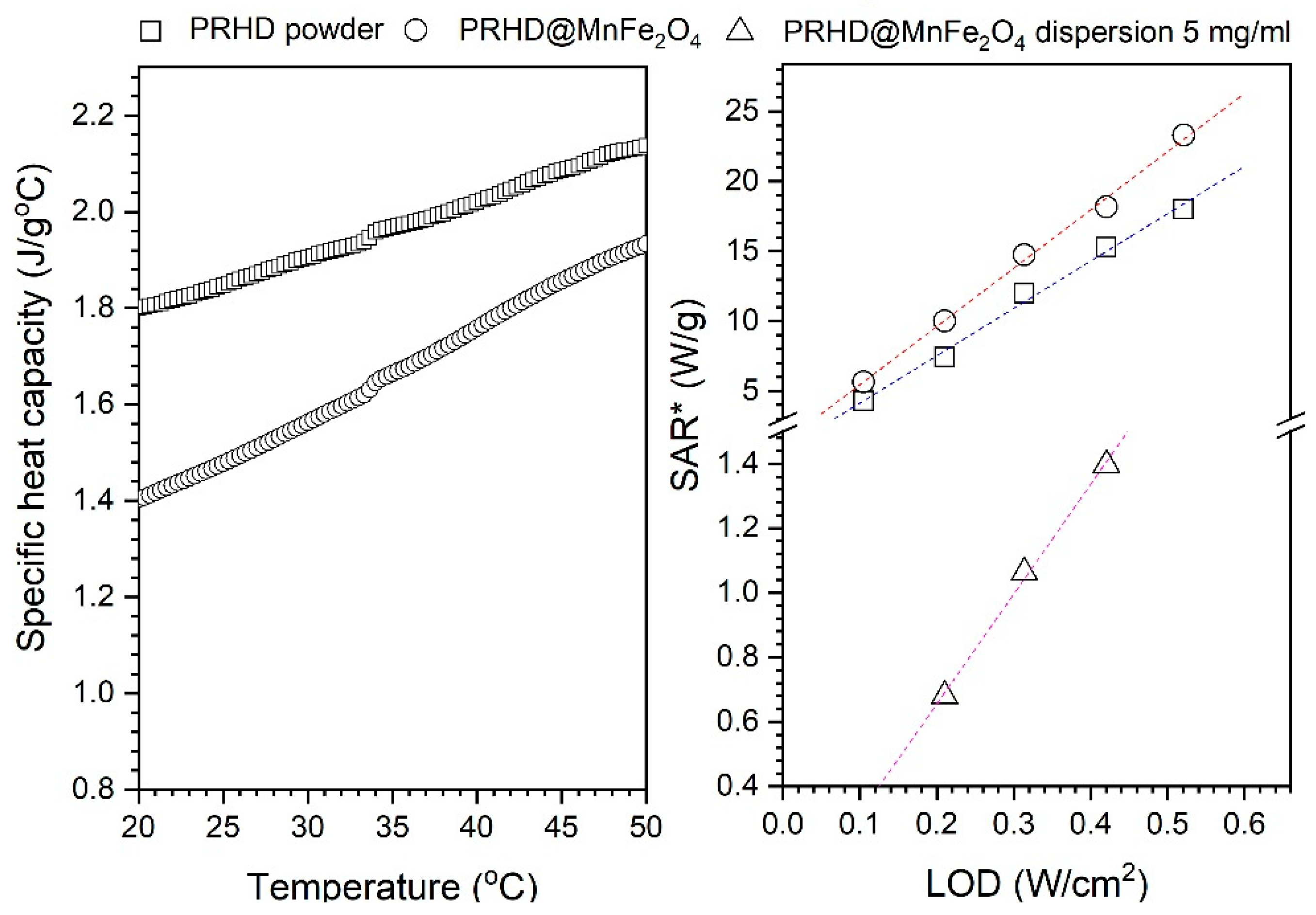


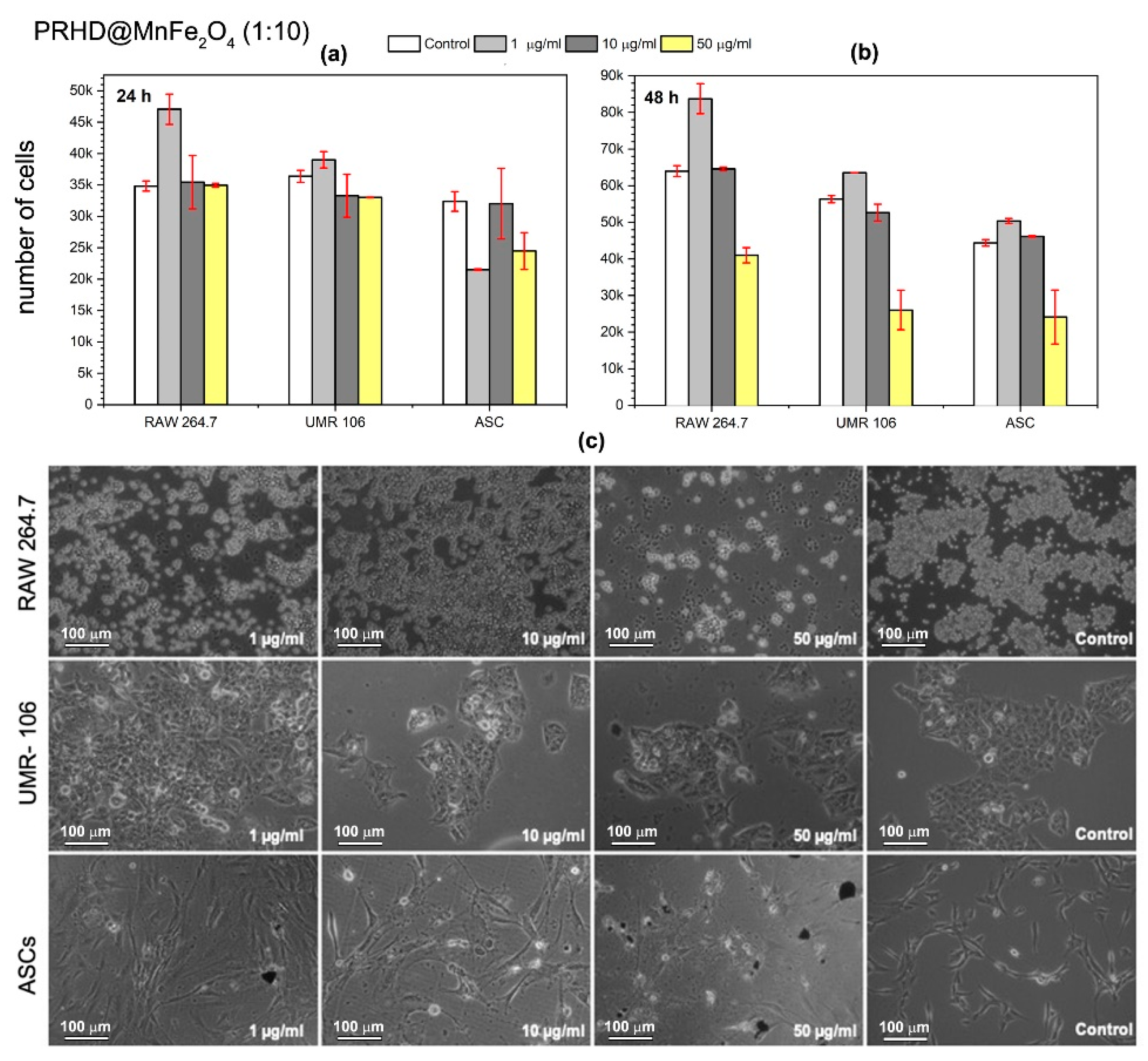
| Sample | LP (mW) | LOD (W/cm2) | dT/dt (°C/s) | SAR (W/g) |
|---|---|---|---|---|
| PRHD | 165 | 0.11 | 2.31 | 4.3 |
| 330 | 0.21 | 4.00 | 7.4 | |
| 493 | 0.31 | 6.47 | 12.0 | |
| 660 | 0.42 | 8.25 | 15.3 | |
| 818 | 0.52 | 9.72 | 18.0 | |
| PRHD@MnFe2O4 | 165 | 0.11 | 3.81 | 5.6 |
| 330 | 0.21 | 6.77 | 10.0 | |
| 493 | 0.31 | 9.95 | 14.7 | |
| 660 | 0.42 | 12.26 | 18.1 | |
| 818 | 0.52 | 15.76 | 23.3 | |
| Dispersion power dependence (5 mg/mL) | ||||
| PRHD@MnFe2O4 | 330 | 0.21 | 0.16 | 0.68 |
| 493 | 0.31 | 0.25 | 1.06 | |
| 660 | 0.42 | 0.33 | 1.40 | |
| Dispersion concentration dependence | ||||
| 1.25 mg/mL | 493 | 0.31 | 0.06 | 0.26 |
| 2.5 mg/mL | 493 | 0.31 | 0.17 | 0.72 |
| 5 mg/mL | 493 | 0.31 | 0.25 | 1.06 |
| Sample | E. coli Inhibition Zone (mm) | S. aureus Inhibition Zone (mm) | ||
|---|---|---|---|---|
| PRHD | 32 | 29 | 31 | 29 |
| PRHD@MnFe2O4 (1:1) | 28 | 27 | 29 | 32 |
| PRHD@MnFe2O4 (1:10) | 24 | 23 | 22 | 19 |
| Control | 0 | 1 | 0 | 1 |
| Sample | E. coli (CFU/mL) | S. aureus (CFU/mL) |
|---|---|---|
| PRHD | 5.0 × 102 | 1.1 × 102 |
| PRHD@MnFe2O4 (1:1) | 1.2 × 102 | 1.8 × 102 |
| PRHD@MnFe2O4 (1:10) | 1.2 × 103 | 1.3 × 103 |
| Control | 1.2 × 105 | 1.3 × 105 |
Publisher’s Note: MDPI stays neutral with regard to jurisdictional claims in published maps and institutional affiliations. |
© 2020 by the authors. Licensee MDPI, Basel, Switzerland. This article is an open access article distributed under the terms and conditions of the Creative Commons Attribution (CC BY) license (http://creativecommons.org/licenses/by/4.0/).
Share and Cite
Zachanowicz, E.; Kulpa-Greszta, M.; Tomaszewska, A.; Gazińska, M.; Marędziak, M.; Marycz, K.; Pązik, R. Multifunctional Properties of Binary Polyrhodanine Manganese Ferrite Nanohybrids—From the Energy Converters to Biological Activity. Polymers 2020, 12, 2934. https://doi.org/10.3390/polym12122934
Zachanowicz E, Kulpa-Greszta M, Tomaszewska A, Gazińska M, Marędziak M, Marycz K, Pązik R. Multifunctional Properties of Binary Polyrhodanine Manganese Ferrite Nanohybrids—From the Energy Converters to Biological Activity. Polymers. 2020; 12(12):2934. https://doi.org/10.3390/polym12122934
Chicago/Turabian StyleZachanowicz, Emilia, Magdalena Kulpa-Greszta, Anna Tomaszewska, Małgorzata Gazińska, Monika Marędziak, Krzysztof Marycz, and Robert Pązik. 2020. "Multifunctional Properties of Binary Polyrhodanine Manganese Ferrite Nanohybrids—From the Energy Converters to Biological Activity" Polymers 12, no. 12: 2934. https://doi.org/10.3390/polym12122934
APA StyleZachanowicz, E., Kulpa-Greszta, M., Tomaszewska, A., Gazińska, M., Marędziak, M., Marycz, K., & Pązik, R. (2020). Multifunctional Properties of Binary Polyrhodanine Manganese Ferrite Nanohybrids—From the Energy Converters to Biological Activity. Polymers, 12(12), 2934. https://doi.org/10.3390/polym12122934






